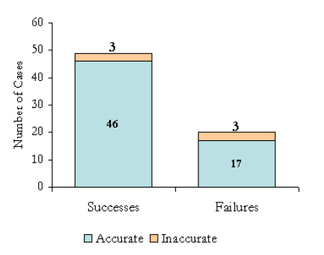The WAGER, Vol. 6 (51) – Predictors of Therapeutic Failure
Past WAGERs (6(14) and 6(45)) have discussed various treatments for gambling and often pointed out the difficulty in assessing a treatment program’s efficacy. Research that evaluates program efficacy tends to emphasize factors that predict successful treatment outcomes. Typically, clinical research does not include factors associated with poor treatment outcomes, perhaps because dropouts and non-compliant subjects are eliminated from the pool of treatment participants. This week’s WAGER examines a study designed to identify factors associated with treatment dropouts and relapses within a one year period following behavioral therapy (Echeburúa et al., 2001). This study provides the opportunity to consider predictive factors for treatment failure, as opposed to success.
Echeburúa, Fernández-Montalvo, and Báez recruited 69 outpatient treatment seekers between February 1994 and March 1996. To be eligible, participants (1) must have scored 5 or more DSM IV criteria, (2) obtained a score of 4 or greater on the South Oaks Gambling Screen (SOGS) (Lesieur & Blume, 1987), (3) had no diagnosed comorbid pathology, and (4) gambled primarily with slot machines. Researchers administered psychological scales that measured various factors that could contribute to treatment failure (i.e. self-esteem, impulsivity, etc.).
Ten (14.5%) of the 69 subjects dropped out of treatment, and another 10 relapsed1 during the 12-month follow-up period. The authors combined the dropouts and the subjects who relapsed into a single “treatment failure” group and compared their characteristics to subjects who completed therapy successfully. A step-wise discriminant analysis identified three variables that significantly contributed to differentiating the groups: satisfaction with the treatment program, alcohol consumption, and neuroticism. The discriminant function correctly classified 91.3% of the cases (Table 1). The “therapeutic failures” were more often dissatisfied with treatment, heavy drinkers, and neurotic. The predictive value of any indicator is always a function of the follow-up term: for example, these predictors might only have value in the short-term (i.e., one year) and not longer.
Figure 1. Accuracy of Group Estimation
This article has some limitations. For example, although Echeburúa et al. omit a description of the behavioral treatment, a description of the treatment is available in another article (Echeburúa et al., 2000). Readers should review the treatment employed in this study before concluding that these findings are applicable to other behavioral treatments. Only 9 of the 69 subjects were women. As a result, this article is unable to provide gender-specific data and the findings might not be applicable to women. Finally, the authors consider dropouts and relapses to be treatment failures. However, some people might have left the program early because they felt that they no longer had a problem, or these participants might have needed a smaller “dosage” of treatment. Similarly, since most people who recover from an excessive pattern of behavior slip or lapse, relapse alone is insufficient to determine treatment failure. Finally, treatment success or failure is often a function of follow-up. Longer term follow-up (i.e. 5 or more years) frequently reveals that short-term success can lead to failure, and short-term failures can yield success (Vaillant, 1983).
Despite these concerns, Echeburúa et al. have made an important contribution to the gambling treatment outcome literature. This study considers the efficacy of treatment from the less-often reported perspective of pre-treatment characteristics that predict dropping out of treatment and relapse. With access to reports that indicate client characteristics predictive of poor outcomes, clinicians might be better able to adjust treatment to prevent premature dropout and, therefore, yield more effective long-term outcomes.
Notes
1 “Relapse” is defined in the study as more than two isolated episodes of gambling in the 12 months post-treatment or a total expense higher than one week of gambling before receiving treatment.
References
Echeburúa, E., Fernández-Montalvo, J., Báez, C. (2001). Predictors of therapeutic failure in slot-machine pathological gamblers following behavioural treatment. Behavioural and cognitive psychotherapy, 29, 379-383.
Echeburúa, E., Fernández-Montalvo, J., Báez, C. (2000). Relapse prevention in the treatment of pathological gambling: long-term outcome. Behavior Therapy, 31, 351-364.
Lesieur, H.R., & Blume, S.B. (1987). The South Oaks Gambling
Screen (SOGS). A new instrument for the identification of pathological gamblers. American Journal of Psychiatry, 144, 1184-1189.
Vaillant, G. E. (1983). The natural history of alcoholism: causes, patterns, and paths to recovery. Cambridge: Harvard University Press.
The WAGER is a public education project of the Division on Addictions at Harvard Medical School. It is funded, in part, by the National Center for Responsible Gaming, the Massachusetts Department of Public Health, the Addiction Technology Transfer Center of New England, the Substance Abuse and Mental Health Services Administration, and the
Center for Substance Abuse Treatment. Copyright ©2001 the President and Fellows of Harvard College
